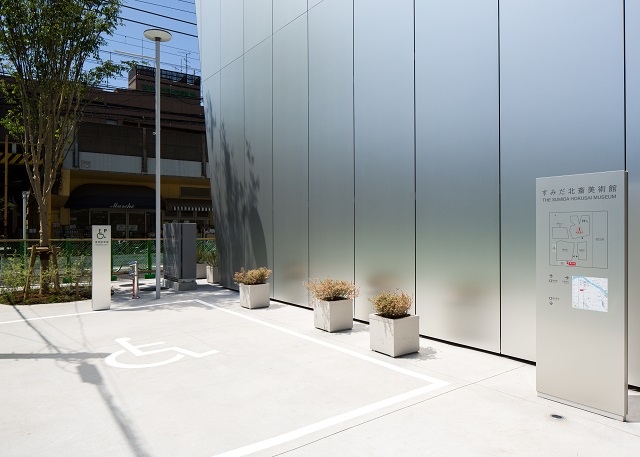
Variously inclined aluminium exterior panels
 The bright aluminium gently reflects its surroundings
The bright aluminium gently reflects its surroundings
 Large cut-edge detailed aluminium panels are installed with thin joints
Large cut-edge detailed aluminium panels are installed with thin joints
■Katsushika Hokusai and Sumida
Katsushika Hokusai was an internationally recognized Japanese Ukiyo-e painter and printmaker of the Edo period, whose best-known works are ‘Thirty-six Views of Mount Fuji’, which includes the iconic ‘The Great Wave’, ‘Find Wind’, and ‘Clear Morning’. Although his recognition was secured through these works on Mount Fuji, Hokusai spent almost his entire life in the Sumida ward.
In his honour, the Sumida Hokusai Museum was built in 2016 to increase the recognition and to display and communicate the appeal of Hokusai’s works.
Kikukawa’s participation in this project began when our team was consulted by the designer Kazuyo Sejima. To implement her competition winning design, Kikukawa’s metal construction consultation extended from the selection of the material, finish and detailed designs; made possible by our involvement from the early stages of the design process.
It was a true honour for Kikukawa to participate in this project as Sumida is the place of birth for our company and remains our home ground for our Tokyo office.
Click here to find out more about Kikukawa Group’s Tokyo Office
■Selecting the Bespoke Finish
The selection of the finish was based on the design concept, a building that ‘gently reflect(s) the surrounding scenery – from the buildings, the sky to the green of the park’. The selected finish was a bespoke electropolished* highly reflective aluminium alloy. The resulting finish is one that realizes a gentle reflection; an ambience different than that of the reflection of polished stainless steel.
To implement a finish that is in line with the designer’s concept, Kikukawa fabricated various samples with different materials and finishes. In close collaboration with the architects, the selected finish was tested and validated through multiple mock-ups to ensure the quality and feasibility.
The usage of electropolished highly reflective aluminium as an exterior in the scale was a new challenge for Kikukawa, and within Japan.
*Electropolishing: also known as electrochemical polishing, anodic polishing, or electrolytics polishing. An electrochemical process that reduces the surface roughness to improve the surface finish.
■Highly Reflective Aluminium (aka Bright Aluminium)
The selected finish uses a specific aluminium alloy known for its highly reflective properties. Within JIS, the alloy code is A5110AP-H24; an alloy equally strong and workable as A3003P, that gains high reflectivity when electropolished then anodized.
For Sumida Hokusai Museum, the finish is obtained by electropolishing, etching and silver anodization of over 20μ.
The fabrication of evenly finished high quality panels required a close collaboration with the anodizing company and Kikukawa’s quality control expertise.
■Designing Details
From the beginning of the project, Kikukawa constructed 1/300 sized 3D models to better understand and share the design vision of the building. The exterior panels are tilted in various angles, and split in various shapes such as pyramids and square columns. Thus, the details of each corner or bending point was challenging. Additionally, the project required thin joints, some with open bottoms.
Kikukawa utilized its expertise in detailed design, and validated its details with 3D CAD to better understand the feasibility. In doing so, Kikukawa realised an 8mm vertical joints, 12mm horizontal joints, both with open bottoms as well as the precise installation of variously shaped panels (over 427 pieces of triangular panels varying in scale).
■Kikukawa’s Installation Craftsmanship
It was clear that the installation of this project was going to be a challenge. The bottom rows were tilted, and the bespoke finish required careful handling. To smooth the process as best as possible, Kikukawa’s detailed designers considered and implemented various adjustments in details such as the subframes.
Kikukawa worked closely with the contractors before installation to share and plan the scaffolding, loading and lifting. In the actual installation process, corners were precisely measured and marked with piano wires. These are only a few of Kikukawa’s installation expertise that enabled the precise installation of panels as large as 1400mm(W) and 5600mm(H), with thin joints.
■Establishing the Technology
The exterior of Sumida Hokusai Museum uses highly reflective electropolished aluminium in a scale largest in Japan. The expertise gained from this project is now established and incorporated into Kikukawa’s technology and craftsmanship.
The design concept and its implementation, in particular the gently reflecting finish are highly regarded in the industry, and the building won the 59th BCS Award**. The positive response to the established building is now leading to an industry wide expectation that the demand of highly reflective elecropolished panels will increase.
**BCS Award: established in 1960 to recognize excellent buildings of the year.
Click here for more information on the BCS award (external link)
Click here to find out more on Kikukawa’s past projects that received the BCS award
The 2016 edition of KIKUKAWA’s season’s greetings focuses on the Sumida Hokusai Museum. Introduces KIKUKAWA’s bright anodized Aluminium exterior panels and features a comment from the designer, Kazuyo Sejima.
Click Here to Download The Brochure
| Product | Material | Metal Finishes or Metalwork |
|---|---|---|
| Exterior Panel | Bright Anodized Aluminium (A5110AP-H24) | Bright Anodized (Electropolishing + Silver Anodized) |
| Project | Sumida Hokusai Museum |
|---|---|
| Client | Sumida Ward |
| Architect | Kazuyo Sejima |
| Contractor | JV by Obayashi Corporation and Tobu Yachida Construction |
| Completion | 2016 |
| Location | Sumida-ku, Tokyo |


